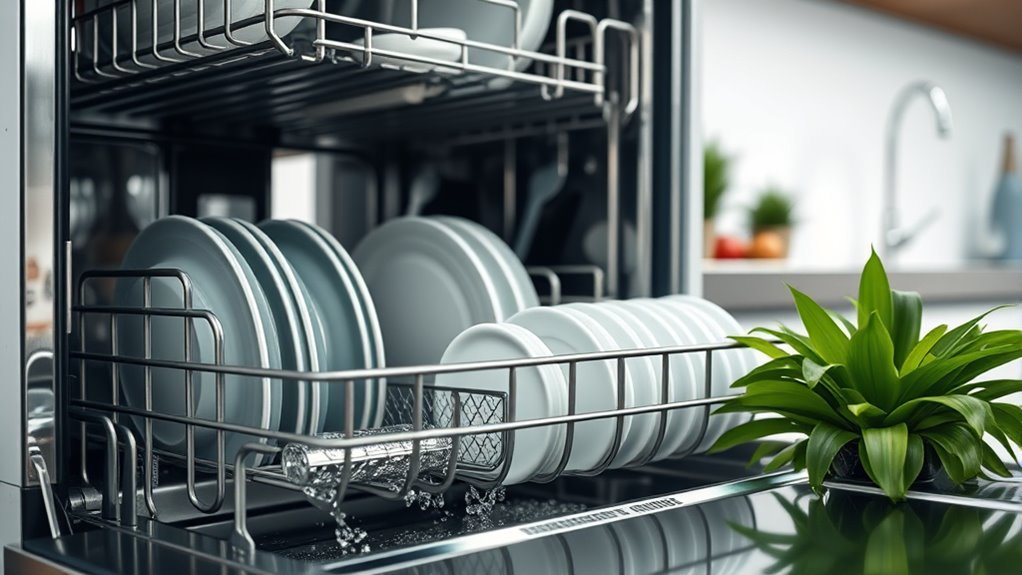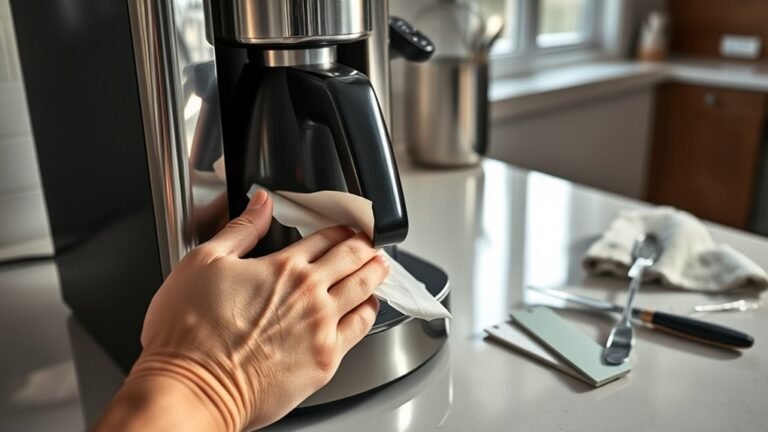Preventing Dirt Buildup on Dishwasher
To prevent dirt buildup in your dishwasher, regularly clean filters, spray arms, and door seals, running an empty cycle with vinegar or a cleaner monthly. Load items properly—avoid overlapping, face dishes toward jets, and place heavy cookware on the bottom rack. Use the right detergent and rinse aid, adjusting amounts for your water hardness. Run hot water before starting to boost cleaning and drying. Proper prep and not overloading guarantee all surfaces get cleaned thoroughly. Staying consistent with these steps maintains peak performance and helps you optimize your appliance’s longevity.
Regular Cleaning and Maintenance
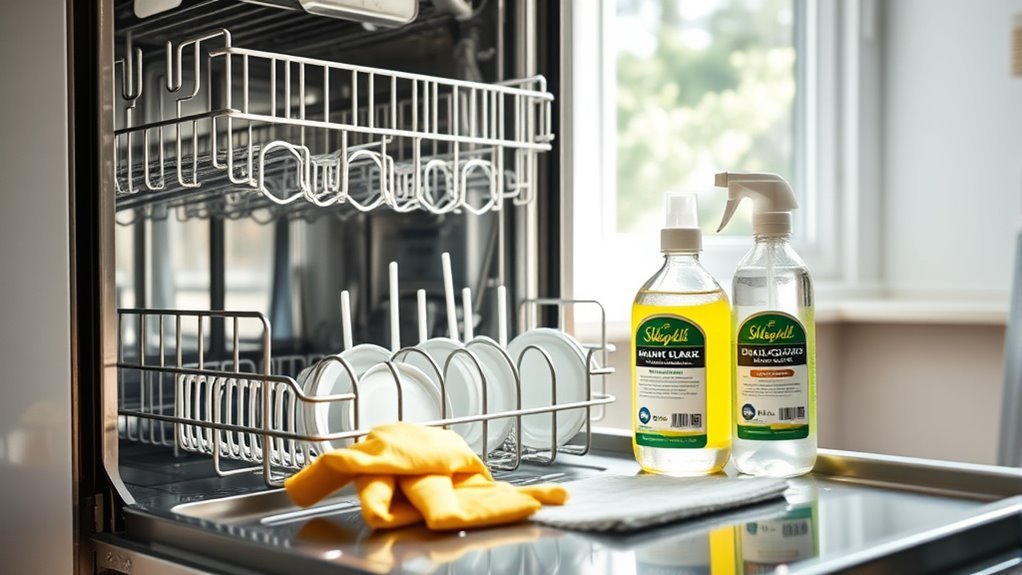
Although dishwashers are designed to clean themselves to some extent, regular cleaning and maintenance are essential to prevent dirt buildup and guarantee peak performance. You should establish a strict cleaning schedule, ideally monthly, to remove food particles, grease, and mineral deposits. Use a maintenance checklist to systematically inspect and clean key components like spray arms, filters, and door seals. This checklist confirms you don’t overlook areas prone to grime accumulation, which can impair water flow and reduce efficiency. Running an empty cycle with dishwasher cleaner or vinegar helps dissolve residues inside the machine. By adhering to this regimen, you maintain your dishwasher’s functionality, avoid costly repairs, and enjoy reliable operation. This disciplined approach grants you the freedom to trust your appliance without frequent interventions.
Proper Loading Techniques
Maintaining your dishwasher through regular cleaning is only part of preventing dirt buildup; how you load your dishes plays a significant role in guaranteeing thorough cleaning and ideal water circulation. Proper dishwasher stacking and dish arrangement optimize spray coverage, reducing residue and buildup.
Keep these techniques in mind:
- Place plates and bowls facing the water jets for effective rinsing.
- Avoid overlapping items to prevent shadowing and trapped debris.
- Position large pots and pans on the bottom rack, angled downward.
- Load glasses and plasticware on the top rack, secured to avoid movement.
- Confirm utensils are spaced and handles face downward to maximize cleaning.
Using the Right Detergents and Rinse Aids
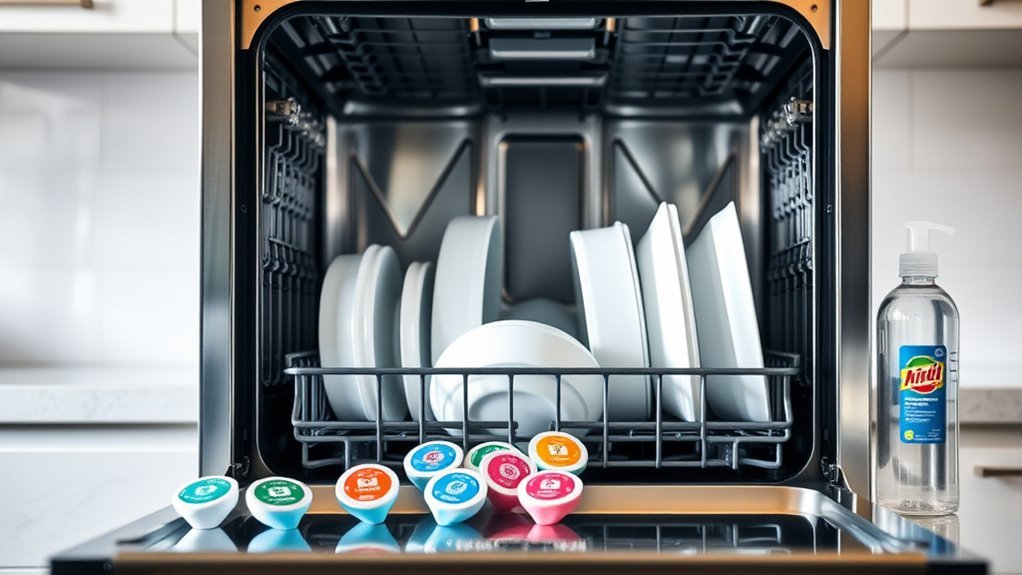
When you choose the right detergents and rinse aids, you’ll enhance your dishwasher’s cleaning efficiency and reduce residue buildup. Proper detergent selection is critical; opt for formulations designed for your water hardness and dishwasher model to prevent mineral deposits and film formation. Powder, gel, and tablet detergents each have distinct dissolution rates—select based on your cycle preferences and soil levels. Incorporating a rinse aid improves water sheeting on dishes, minimizing spotting and accelerating drying. It also prevents water droplets from clinging, which curbs residue accumulation inside the dishwasher. Use the recommended amount of both detergent and rinse aid to maintain peak performance without excess chemical residues. Carefully managing these variables guarantees your dishwasher operates cleanly and reliably, giving you the freedom to enjoy spotless dishes without extra maintenance.
Checking and Cleaning Dishwasher Filters
You’ll first need to locate the dishwasher filters, usually found at the bottom of the tub. Carefully remove the filter components according to your model’s instructions to avoid damage. Then, use warm water and a soft brush to clean away trapped debris, ensuring peak performance and preventing buildup.
Locating Dishwasher Filters
One essential step in preventing dirt buildup on your dishwasher is locating and accessing its filters for regular inspection and cleaning. Dishwashers typically have multiple filter types designed to trap food particles and debris, vital for peak performance. Knowing the filter locations helps you maintain efficiency and avoid clogs.
Common filter types and their locations include:
- Coarse filters near the bottom to catch large debris
- Fine mesh filters situated beneath the spray arm to trap smaller particles
- Micron filters integrated into the sump area for ultra-fine filtration
- Self-cleaning filters housed within the base, often requiring less frequent attention
- Removable filters positioned on the dishwasher floor for easy access
Identifying these filter types and locations guarantees you can keep your dishwasher running smoothly and dirt-free.
Removing Filter Components
Begin by carefully removing the dishwasher’s filter components to inspect and clean them effectively. Typically located at the bottom of the dishwasher tub, the filter assembly includes a coarse filter and a fine mesh screen. Release or twist the filter housing as per your model’s instructions to detach it without damage. Proper filter maintenance requires you to check for accumulated debris, food particles, and mineral buildup that can impair performance. Regularly removing these components allows you to identify wear or damage early, signaling when filter replacement is necessary to maintain peak operation. Handle each part with care to avoid distortion or cracks, which compromise filtration. Consistent filter removal and inspection grant you control over your dishwasher’s cleanliness, ensuring freedom from clogs and odors.
Cleaning Techniques and Tips
After removing the filter components, inspect them closely for debris and buildup that can hinder dishwasher efficiency. Effective dishwasher maintenance relies on regularly checking and cleaning filters according to established cleaning schedules. Neglecting this can reduce water flow and leave residue on dishes. To maintain peak performance, follow these cleaning techniques:
- Rinse filters under warm running water to remove loose particles.
- Use a soft brush to gently scrub away stuck-on grease and food remnants.
- Avoid harsh chemicals; mild detergent guarantees safe cleaning without damaging parts.
- Reassemble filters carefully, making sure all seals fit correctly to prevent leaks.
- Schedule filter cleaning every 1-3 months, adjusting based on load frequency and soil levels.
Running Hot Water Before Starting the Dishwasher
Before starting your dishwasher, run the hot water tap until the water reaches its maximum temperature. This guarantees the dishwasher begins its cycle with hot water, improving detergent effectiveness and reducing residue buildup. Taking this simple step helps maintain peak cleaning performance and prevents dirt accumulation inside the appliance.
Benefits of Hot Water
Running hot water for just 30 seconds before starting your dishwasher guarantees the appliance receives water at an ideal temperature, typically above 120°F (49°C). This temperature impact guarantees maximum cleaning efficiency and prevents residue buildup. Understanding the hot water benefits can help you maintain your dishwasher’s performance and extend its lifespan.
Here’s what you gain by running hot water beforehand:
- Enhances detergent activation for thorough cleaning
- Reduces grease and food particle adhesion
- Minimizes bacterial growth due to higher wash temperatures
- Prevents thermal shock to dishwasher components
- Improves drying efficiency by raising internal temperature
How to Run Hot Water
To guarantee your dishwasher operates at peak efficiency, start by letting hot water flow from the kitchen sink for about 30 seconds until it reaches a steady high temperature, typically above 120°F (49°C). This guarantees the incoming water temperature entering the dishwasher is sufficiently hot from the start. Running hot water beforehand reduces the dishwasher’s initial heating time, improving cleaning performance and preventing detergent clumping.
Measure the water temperature with a thermometer to confirm it’s within the ideal range. If the water isn’t hot enough, adjust your water heater settings accordingly. Consistently maintaining ideal water temperature not only enhances soil removal but also minimizes residue buildup inside the dishwasher. By controlling your hot water supply before each cycle, you maximize cleaning efficiency and extend the appliance’s operational freedom without unnecessary energy waste.
Avoiding Overloading and Pre-Rinsing Dishes
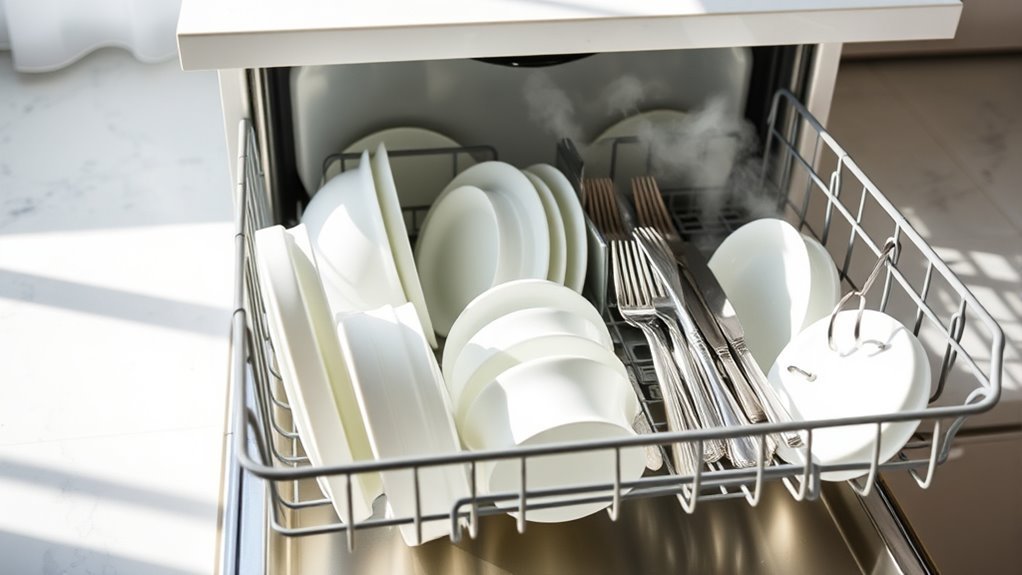
Although it might seem efficient to pack your dishwasher to its capacity, overloading can prevent water and detergent from reaching all surfaces, resulting in dirt buildup. Proper dish preparation, including pre-rinsing, is essential for effective dirt prevention and ideal cleaning performance.
To avoid overloading and guarantee efficient dish preparation:
- Space items to allow unrestricted water flow.
- Place large, heavily soiled items on the bottom rack.
- Avoid nesting dishes, which traps food particles.
- Pre-rinse only if food residues are stubborn or dry.
- Use the appropriate detergent dose for load size.
Frequently Asked Questions
Can Vinegar Damage Dishwasher Components Over Time?
You might wonder if vinegar effects could harm your dishwasher components over time. While vinegar is acidic and can clean mineral deposits, frequent or undiluted use may corrode rubber seals and metal parts, potentially reducing dishwasher longevity. To protect your appliance, use vinegar sparingly and diluted, or opt for manufacturer-approved cleaners. This way, you maintain cleaning freedom without risking damage to essential dishwasher components.
How Often Should Dishwasher Spray Arms Be Replaced?
Did you know that about 30% of dishwasher performance issues stem from spray arm problems? For peak function, the replacement frequency of dishwasher spray arms typically ranges from every 3 to 5 years, depending on usage and wear. Regular spray arm maintenance—such as cleaning clogged holes and checking for cracks—can extend their life. By staying proactive, you guarantee efficient cleaning without sacrificing your freedom to enjoy hassle-free dishwashing.
Is It Safe to Use Bleach in a Dishwasher?
You shouldn’t use bleach in your dishwasher because it can corrode metal parts and damage rubber seals, compromising dishwasher maintenance. Instead, opt for bleach alternatives like vinegar or citric acid, which effectively sanitize without harming components. These alternatives keep your dishwasher in good shape while maintaining cleaning power. By choosing safer options, you guarantee your dishwasher lasts longer and operates efficiently, giving you the freedom to clean confidently without risking damage.
What Causes Dishwasher Odors Besides Dirt Buildup?
Besides dirt buildup, dishwasher odors often come from trapped food residue that decomposes over time. Stagnant water in the filter or spray arms can also create a breeding ground for bacteria, which produces unpleasant smells. To keep your dishwasher smelling fresh, regularly clean the filter and run maintenance cycles using specialized cleaners. Ensuring proper drainage helps prevent stagnant water, minimizing odor sources and keeping your appliance running efficiently.
Can Hard Water Affect Dishwasher Cleaning Performance?
You might find your dishwasher’s sparkle slightly dulled by what’s often called “nature’s little deposits”—hard water. This water, rich in minerals, can cause mineral buildup inside your dishwasher, impacting its cleaning performance. These deposits can cling to internal parts and dishes, reducing efficiency and leaving spots. To maintain freedom from such nuisances, consider water softeners or specialized detergents designed to combat hard water’s effects and keep your dishwasher running smoothly.
